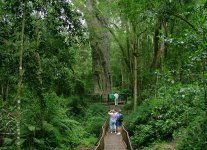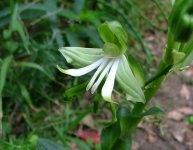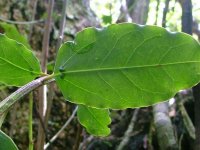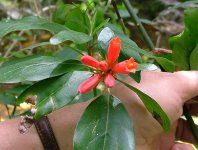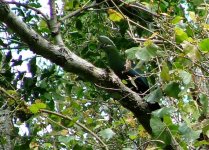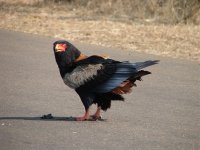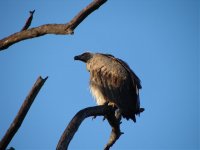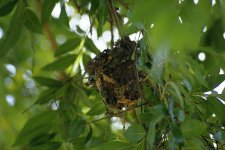Garden Route Birding 5
Apologies for the delay in posting this episode - the rains have arrived, and the abundance of lightning has kept me off the air.
4. Forest
When birding in forest habitat you REALLY need to know your bird calls. It is hugely helpful in locating your target species. Keep your eyes and ears open for signs of a bird party – they can be really rewarding. Stop frequently and listen – the contact calls of
Terrestrial Brownbul, Grey Cuckooshrikeand
Knysna Warbler, for example, are very quiet, and require careful listening to detect. Look around you and above you frequently, watching for any movement that is not the wind playing with a leaf. Take a 15-minute break in likely areas, sit down, and just listen and observe. And don’t forget the wonderful plants, fungi, and insects that are all part of the forest ambience. There are many forest areas to be visited, but here are two of the less strenuous.
Woodville Forest
http://www.multimap.com/s/xVcyxKiI
Directions
Take the N2 from Wilderness towards Sedgefield, and a little way along that road take the turn to the left signposted Hoekwil. The road descends to and then traverses extensive reedbeds and the Serpentine, the channel which connects Island Vlei, Langveli and Rondevlei with the Touw River estuary. Stop where safe to do so and do a little birding to put you in the mood. The road soon reaches the base of the steep rise leading up to the extensive wave-cut platform, and climbs steeply onto this feature which supports extensive agricultural enterprise. As you continue across the farm land you will see the Outeniqua Mountains rising ahead of you, with a band of forest along their base. Once past Hoekwil, you will see a road to George slipping off to the left. Continue on round a a long right hand bend so that you are now travelling sub-parallel to the mountains. Some way along you will see a brown tourist sign to the Woodville ‘Big Tree’. Turn in there, and follow the little dirt road to the parking spot. You will see the beginning of the trail on the right of the road. Go to the Big Tree – a gigantic
Podocarpus falcatus – and follow the signs round the 2km forest trail.
We had to work hard on this most recent visit to Woodville, but ended up with some fine sightings. These, plus some previous sightings, are listed below……
Olive Woodpecker, Cape Batis, Yellow-throated Woodland Warbler, Black-headed Oriole, Grey Cuckooshrike, Southern Double-collared Sunbird, Terrestrial Brownbul, Green Wood-hoopoe, Red-chested Cuckoo (heard), Lesser Honeyguide (heard), Knysna Warbler (heard), Cape White-eye, African Dusky Flycatcher, Narina Trogon, Chorister Robin-chat, Green-backed Eremomela, Puffback, Emerald Cuckoo (heard), White-starred Robin (heard)
I have attached five photos from Woodville. You will notice that only one is a bird…..it is very difficult obtaining good bird pictures in a forest. I hope the pictures will, however, convey something of the atmosphere of this fascinating habitat.
The first photo shows a fine
Podocarpus falcatus, the
Outeniqua Yellowwood, and gives some idea of the size of these splendid trees. The second shows the beautiful
Green Wood Orchid Bonatea speciosa. The third is the leaf of the
Stinkwood Ocotea bullata. The two little bumps at the leaf base are characteristic. The fourth is the pretty flower of Wild Pomegranate
Burchellia bubaline, while the fifth is the one and only bird, the famous
Knysna Turaco, f.k.a. Knysna Lourie
Tauraco corythaix.
Jubilee Creek
http://www.multimap.com/s/uSZ2xIu6
Directions
Drive 7km west from Knysna on the N2, and nerar the top of a long hill you will see the sign to Rheenendal. Take this road for 13km, when you will see the turn-off to the Goudveld State Forest and Millwood Gold Fields. 2.3km up this road is a small shelter on the right where you must register for the walk. 5km further on you will see a turn-off to the left signposted Jubilee Creek picnic site.
Jubilee Creek forms part of the Outeniqua Trail. All this area was prospected during the Millwood gold rush in the 1880’s. The forest has amazing powers of recovery. See how many signs you can find of the old gold rush days. The trail runs for about 2km to a pool where you can cool off on a hot day, and then returns the same way, making 4km in all. You can rest and picnic at the picnic site should you so wish. One one occasion a Half-collared Kingfisher was working the stream where it ran through the picnic area, and allowed a surprisingly close approach.
But the best Jubilee Creek story was the time we were unpacking the car boot just as a troop of weary, footsore hikers came tottering along the trail. One of them stopped at the edge of the stream, took off his boots and socks, and plunged his feet into the water. You could almost see the steam rising. As we were getting the picnic goodies out of the boot a Knysna Lourie (Turaco) flew across the clearing on scarlet wings.
“Wow! Look at that!” we chorused.
“A Knysna Lourie! What a sighting!!”
The footsore hiker glared at us.
“Did you,” he asked in measured tones,
“just see a Knysna Lourie?”
“Yes!”we chorused happily.
“He flew across the clearing right now, just when you stuck your feet into the water.”
“Do you realise,” he hissed though gritted teeth,
“that I have been walking this *#!%@!$ trail for eight *#!%@!$ days, my feet are *#!%@!$ killing me, and so far I have not seen so much as a *#!%@!$ feather of a *#!%@!$ Knysna Lourie….and you come along in your fancy *#!%@!$ car and see one within 35 seconds!”
For the sake of his good health and continuing survival we waited until we were well away before bursting into unseemly laughter.
Perhaps because of all the hikers, I feel the Jubilee Creek birds are perhaps somewhat shyer than the Woodville ones, but you never know what will happen when birding. Although we did not visit Jubilee Creek on this trip I have seen or heard on previous visits Lemon Dove, Narina Trogon (heard), Knysna Turaco, Olive Thrush, Terrestrial Brownbul, Cape White-eye, Half-collared Kingfisher, Black-headed Oriole, African Dusky Flycatcher, Cape Batis, Cape Bulbul.
Take someone with you in the forest, and never leave the path. It is VERY easy to get lost.
Best wishes,
Dave Kennedy




